: 2025
: 2024
: 2023
: 2022
: 2021
: 2020
: 2019
: 2018
: 2017
: 2016
: 2015
: 2014
: 2013
: 2012
: 2011
: 2010
: 2009
: 2008
: 2007
:



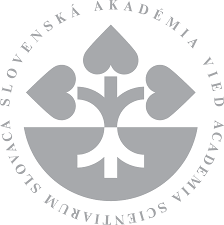


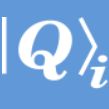
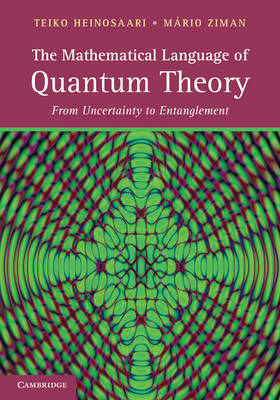
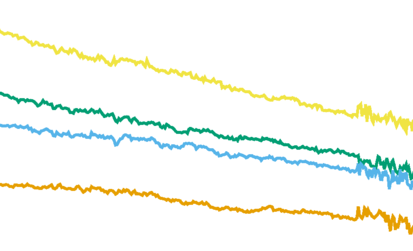 12.12.2019 Publication
12.12.2019 Publication
Observation of quantum corrections to conductivity up to optical frequencies
It is well known that the conductivity of disordered metals is suppressed in the limit of low frequencies and temperatures by quantum corrections. Although predicted by theory to exist up to much higher energies, such corrections have so far been experimentally proven only for ≲80 meV. Here, by a combination of transport and optical studies, we demonstrate that the quantum corrections are present in the strongly disordered conductor MoC up to at least ∼4 eV, thereby extending the experimental window where such corrections were found by a factor of 50. The knowledge of both the real and imaginary parts of conductivity enables us to identify the microscopic parameters of the conduction electron fluid. We find that the conduction electron density of strongly disordered MoC is surprisingly high and we argue that this should be considered a generic property of metals on the verge of a disorder-induced localization transition.
by
P. Neilinger, J. Greguš, D. Manca, B. Grančič, M. Kopčík, P. Szabó, P. Samuely, R. Hlubina, and M. Grajcar
Physical Review B 100, 241106 (2019) | +++ | |
 06.12.2019 seminar
06.12.2019 seminar
Nonlocal seminar Traditional informal gathering of our group with the research group of Marcus Huber from Vienna will happen on 12/12/2019 afternoon. This time we will meet in Bratislava. Program:
|
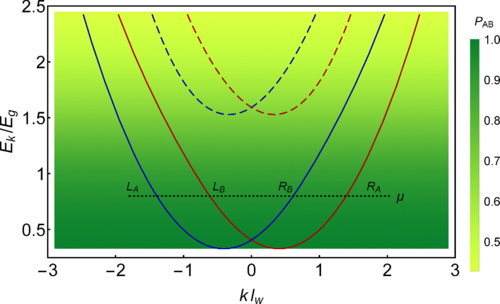 21.11.2019 Publication
21.11.2019 Publication
Charge transport of a spin-orbit-coupled Luttinger liquid
The charge transport of a (Tomonaga-)Luttinger liquid with tunnel barriers exhibits universal scaling: the current-voltage curves measured at various temperatures collapse into a single curve upon rescaling. The exponent characterizing this single curve can be used to extract the strength of electron-electron interaction. Motivated by a recent experiment on InAs nanowires [Y. Sato et al., Phys. Rev. B 99, 155304 (2019)], we theoretically investigate the analogous behavior of a spin-orbit-coupled Luttinger liquid. We find that the scaling exponent differs for different impurity strengths, being weak (disorder potential) or strong (tunnel barriers), and their positions, either in the bulk or near the edge of the wire. For each case we quantify the exponent of the universal scaling and its modification due to the spin-orbit coupling. Our findings serve as a guide in the determination of the interaction strength of quasi-one-dimensional spin-orbit-coupled quantum wires from transport measurements.
by
Chen-Hsuan Hsu, Peter Stano, Yosuke Sato, Sadashige Matsuo, Seigo Tarucha, and Daniel Loss
Phys. Rev. B 100, 195423 (2019) | +++ | |
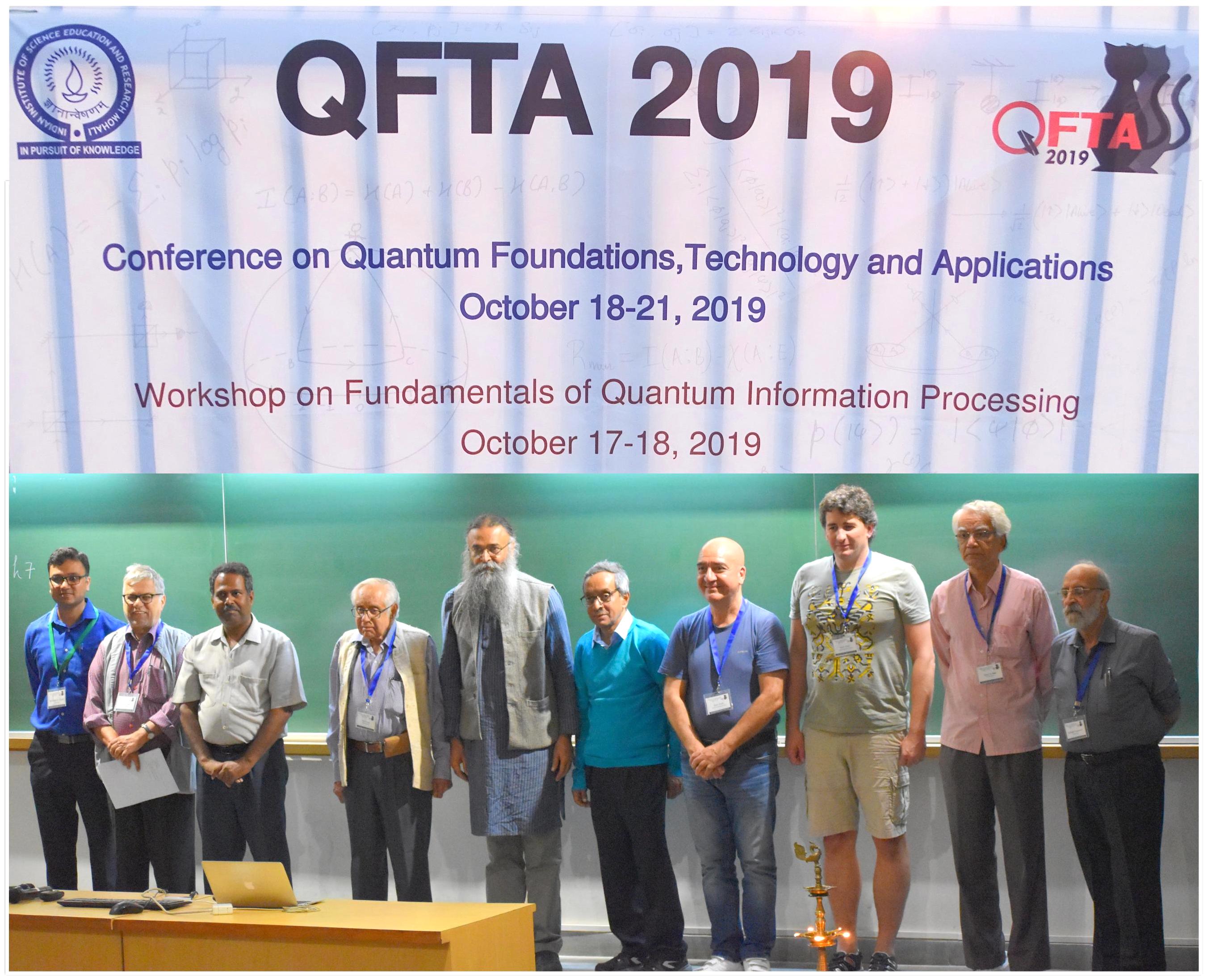 18.10.2019 Invited talk
18.10.2019 Invited talk
Incompatibility and nonlocality of quantum process measurements at Quantum foundations, technology and applications (QFTA2019), IISER Mohali, India | +++ | by Mario Ziman We will formulate the mathematical theory of process observables and investigate the concepts of incompatibility. We will show that unlike for case of POVMs the process observables achieves the maximal incompatibility for finite-dimensional case. Moreover, the maximally incompatible process observables are commuting. Motivated by the relation between the degree of incompatibility and violation of nonlocality we give an example of PR box realization with process observables. |
 17.10.2019 Invited lecture
17.10.2019 Invited lecture
Quantum Encryption at Workshop on fundametals of quantum information processing, IISER Mohali, India | +++ | by Mario Ziman Replacing classical bits by quantum ones in the classical one-time pad encryption scheme we will obtain protocols for quantum teleportation, quantum dense coding, private quantum channels, etc. |
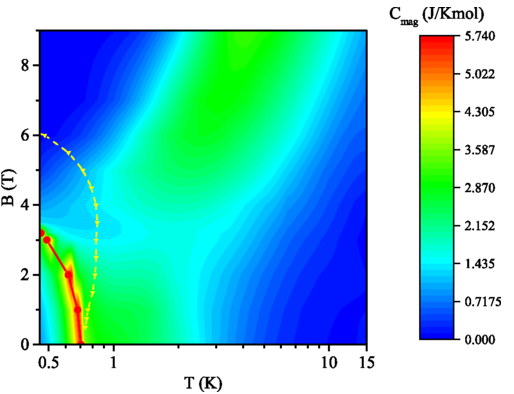 11.10.2019 Publication
11.10.2019 Publication
Interplay of magnetic field and interlayer coupling in the quasi-two-dimensional quantum magnetCu(en)Cl2: Realization of the spin-1/2 rectangular/zigzag square Heisenberg lattice
The interplay of the magnetic field and interlayer correlations was experimentally investigated in a quasi-two-dimensional quantum magnet Cu(en)Cl2. For this purpose, extensive quantum Monte Carlo (QMC) studies of the finite-temperature properties of the spin-1/2 Heisenberg antiferromagnet (HAF) on the rectangular and the spatially anisotropic zig-zag square lattices were performed. The QMC studies revealed the equivalency of both models for any values of magnetic fields and spatial anisotropies R=Jinterchain/Jintrachain. The analysis based on the decomposition of both lattices into local Hamiltonians confirmed the equivalence. Despite the large influence of the interlayer coupling and rather complicated distribution of the intralayer exchange pathways in Cu(en)Cl2, considering several constraints in the data analysis enabled the extraction of the main features of the low-dimensional magnetic subsystem from the specific heat and magnetization. It was found that Cu(en)Cl2 can be treated as the realization of the spin-1/2 HAF on the rectangular/zig-zag square lattice with the intralayer spatial anisotropy R≈0.2, the intrachain exchange coupling 2.20 ± 0.15 K, the saturation field 3.7 ± 0.1 T, the spin-flop field about 0.1 T, and the spin anisotropy of the orthorhombic symmetry. The possibility to investigate magnon instabilities in the strong-field regime of Cu(en)Cl2 is discussed.
by
L. Lederová, A. Orendáčová, R. Tarasenko, K. Karľová, J. Strečka, A. Gendiar, M. Orendáč, and A. Feher
Physical Review B 100, 134416 (2019) | +++ | EXSES APVV-16-0186 |
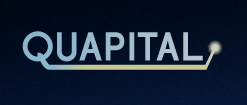 17.10.2019 School lectures
17.10.2019 School lectures
at 2019 Quapital summer school, Bratislava, Slovakia | +++ | speakers from RCQI:
|
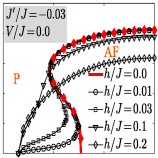 19.09.2019 Publication
19.09.2019 Publication
Influence of applied electric and magnetic fields on a thermally-induced reentrance of a coupled spin-electron model on a decorated square lattice
The combination of an exact and Corner Transfer Matrix Renormalization Group (CTMRG) methods is used to study an influence of external electric and magnetic fields on existence of intriguing reentrant magnetic transitions in a coupled spin-electron model on a decorated square lattice. The two-dimensional (2D) decorated square lattice with localized nodal spins and delocalized electrons is taken into account. It was found that the competition among all involved interactions (the electron hopping, spin-spin and spin-electron interaction, external electric and magnetic fields) in combination with thermal fluctuations can produce new type of reentrant magnetic transitions. Depending on the model parameters the non-zero fields can stabilize or destabilize magnetic reentrance. In addition, an alternative and more effective way, for modulating the magnetic reentrance is found. An origin of intriguing low-temperature round maximum in the specific heat was explained as a consequence of rapid changes in the sublattice magnetizations, which is induced through a competition of all presented interactions.
by
Hana Čenčariková, Jozef Strečka, Andrej Gendiar
Physica E 115, 113717 (2020) | +++ | EXSES APVV-16-0186 |
 04.09.2019 School
04.09.2019 School
QUAPITAL SUMMER SCHOOL 2019 Summer school for students from the QUAPITAL consortium, but open for all participants, is scheduled for 30/09/2019 - 06/09/2019 and organized at the Research Center for Quantum Information in Bratislava. More details and registration form are available on the school website https://quapital.eu/index.php?id=105 |
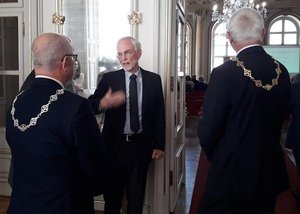 03.09.2019 Award
03.09.2019 Award
Slovak Academy Award for Mark Hillery Mark is our long-term collaborator and we are very happy he was awarded this prestigous prize. Congratulations! Mark has started to work in early 90s with Vladimír Bužek on quantum optics exactly when ideas around quantum information has emerged. Together they have published approx 50 research papers. The papers on approximate quantum cloning and quantum secret sharing cryptographic protocol have significantly impacted the field and belong to most cited physics research papers in Slovakia. Read more (in Slovak): • Medzinárodná cena SAV 2019 (video) • Medzinárodnú cenu Slovenskej akadémie vied si prevzal Mark Hillery • Americký fyzik: Slovenskí vedci sú mimoriadne dobrí. V zahraničí majú dobré meno (interview for newspaper Sme) • Fyzik ocenený SAV: Kvantové počítače by prelomili takmer každé heslo, naše súkromie by sa narušilo (interview for newspaper DennikN) • Vedci sa pokúšajú zostrojiť kvantový počítač • |
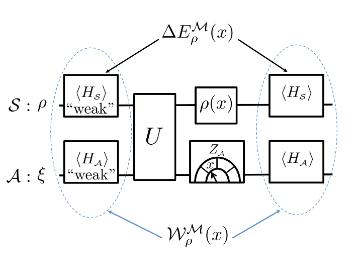 19.08.2019 Publication
19.08.2019 Publication
Conditional work statistics of quantum measurements
In this paper we introduce a definition for conditional energy changes due to general quantum measurements, as the change in the conditional energy evaluated before, and after, the measurement process. By imposing minimal physical requirements on these conditional energies, we show that the most general expression for the conditional energy after the measurement is simply the expected value of the Hamiltonian given the post-measurement state. Conversely, the conditional energy before the measurement process is shown to be given by the real component of the weak value of the Hamiltonian. Our definition generalises well-known notions of distributions of internal energy change, such as that given by stochastic thermodynamics. By determining the conditional energy change of both system and measurement apparatus, we obtain the full conditional work statistics of quantum measurements, and show that this vanishes for all measurement outcomes if the measurement process conserves the total energy. Additionally, by incorporating the measurement process within a cyclic heat engine, we quantify the non-recoverable work due to measurements. This is shown to always be non-negative, thus satisfying the second law, and will be independent of the apparatus specifics for two classes of projective measurements.
by
M. Hamed Mohammady and Alessandro Romito
Quantum 3, 175 (2019) | +++ | NONE |
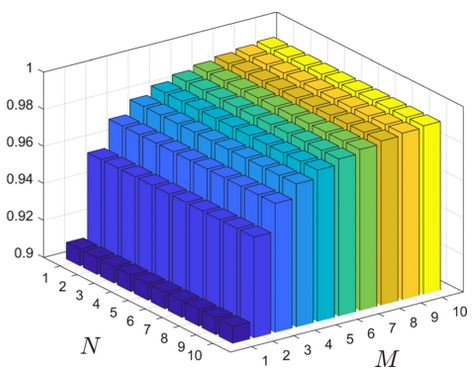 16.07.2019 Publication
16.07.2019 Publication
Efficiency of a cyclic quantum heat engine with finite-size baths
In this paper we investigate the relationship between the efficiency of a cyclic quantum heat engine with the Hilbert space dimension of the thermal baths. By means of a general inequality, we show that the Carnot efficiency can be obtained only when both the hot and cold baths are infinitely large. By further introducing a specific model where the baths are constituted of ensembles of finite-dimensional particles, we further demonstrate the relationship between the engine's power and efficiency, with the dimension of the working substance and the bath particles.
by
M. Hamed Mohammady and Alessandro Romito
Phys. Rev. E 100, 012122 (2019) | +++ | NONE |
 17.6.2019 Conference talk
17.6.2019 Conference talk
Divisibility of qubit channels and dynamical maps at 51 Symposium on Mathematical Physics, Torun, Poland | +++ | by Mário Ziman The concept of divisibility of dynamical maps is used to introduce an analogous concept for quantum channels by analyzing the simulability of channels by means of dynamical maps. In particular, this is addressed for Lindblad divisible, completely positive divisible and positive divisible dynamical maps. The corresponding L-divisible, CP-divisible and P-divisible subsets of channels are characterized (exploiting the results by Wolf et al.) and visualized for the case of qubit channels. We discuss the general inclusions among divisibility sets and show several equivalences for qubit channels. To this end we study the conditions of L-divisibility for finite dimensional channels, especially the cases with negative eigenvalues, extending and completing the results. Furthermore we show that transitions between every two of the defined divisibility sets are allowed. We explore particular examples of dynamical maps to compare these concepts. Finally, we show that every divisible but not infinitesimal divisible qubit channel (in positive maps) is entanglement-breaking. This is a joint work with David Davalos and Carlos Pineda. |
 6.6.2019 Conference talk
6.6.2019 Conference talk
Very entangled spin chains and combinatorial techniques in condensed matter physics at CEQIP 2019, Skalica, Slovakia | +++ | by Libor Caha How entangled can a ground state of a simple quantum matter be? It turns out that power law violation of entanglement entropy is possible, as shown for recent Motzkin spin-2 and Fredkin spin-3/2 chains. We demonstrate that one can find such surprising properties even in spin-1 chains (qutrits on a line). We present the PF model, a translationally invariant spin chain with 1/poly(N) gap, sqrt(N) half-chain entropy for a particular ground state (conjecture: can be made unique, partial analytical result). Building on combinatorial techniques, we use correspondence to relate entropy of a middle part (also for Fredkin and Motzkin chains), derive 1 and 2-point correlation functions, and violation of the cluster decomposition property. We discuss these models with periodic boundary conditions. |
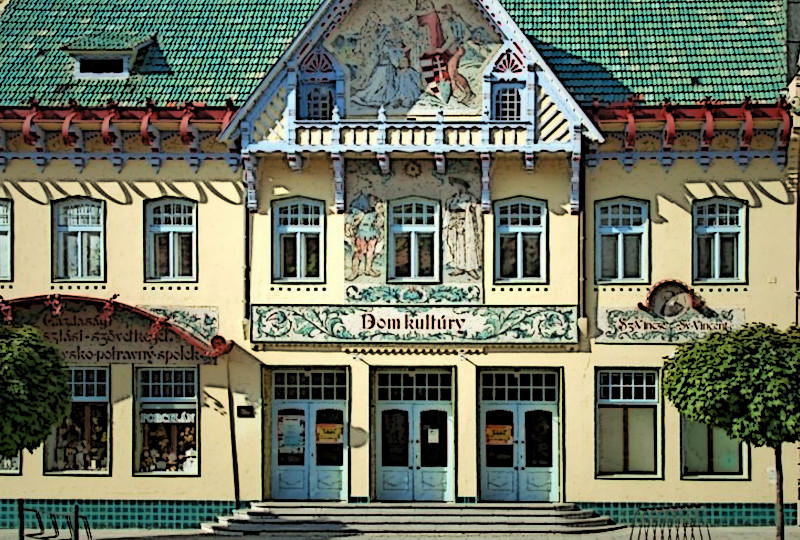 03.06.2019 Conference
03.06.2019 Conference
CEQIP 2019 We are happy to announce that 16th CEQIP workshop will be held in June (3-6) and this year we will explore a completely new venue - kings town Skalica (Vitriol). We expect the registration and the submission will be open in February and closed in mid March. Looking forward to see you there. http://ceqip.eu/2019/ |
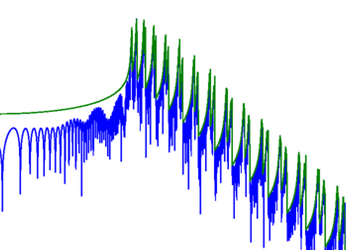 26.05.2019 Publication
26.05.2019 Publication
Degeneracy lifting of Majorana bound states due to electron-phonon interactions
We study theoretically how electron-phonon interaction affects the energies and level broadening (inverse lifetime) of Majorana bound states (MBSs) in a clean topological nanowire at low temperatures. At zero temperature, the energy splitting between the right and left MBSs remains exponentially small with increasing nanowire length L. At finite temperatures, however, the absorption of thermal phonons leads to the broadening of energy levels of the MBSs that does not decay with system length, and the coherent absorption/emission of phonons at opposite ends of the nanowire results in MBSs energy splitting that decays only as an inverse power law in L. Both effects remain exponential in temperature. In the case of quantized transverse motion of phonons, the presence of Van Hove singularities in the phonon density of states causes additional resonant enhancement of both the energy splitting and the level broadening of the MBSs. This is the most favorable case to observe the phonon-induced energy splitting of MBSs as it becomes much larger than the broadening even if the topological nanowire is much longer than the coherence length. We also calculate the charge and spin associated with the energy splitting of the MBSs induced by phonons. We consider both a spinless low-energy continuum model, which we evaluate analytically, as well as a spinful lattice model for a Rashba nanowire, which we evaluate numerically.
by
Pavel P. Aseev, Pasquale Marra, Peter Stano, Jelena Klinovaja, and Daniel Loss
Phys. Rev. B 99, 205435 (2019) | +++ | NONE |
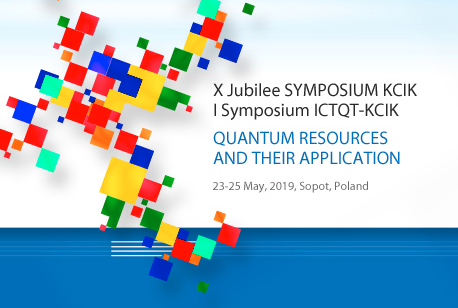 24.5.2019 Invited talk
24.5.2019 Invited talk
Quantum learning of quantum gates at ICTQT+KCIK Symposium: Quantum resources and their applications, Sopot, Poland | +++ | by Mário Ziman The question of a quantum memory storage of quantum dynamics will be investigated. In particular, I will design an optimal protocol for N -> 1 probabilistic storage-and-retrieval of unitary channels on d-dimensional quantum systems. If we may access the unknown unitary gate only N-times, the optimal success probability of perfect retrieval of its single use is N/(N−1+d^2). The derived size of the memory system exponentially improves the known upper bound on the size of the program register needed for probabilistic programmable quantum processors. These results are closely related to probabilistic perfect alignment of reference frames and probabilistic port-based teleportation. |
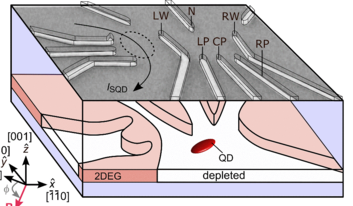 22.05.2019 Publication
22.05.2019 Publication
Spectroscopy of Quantum Dot Orbitals with In-Plane Magnetic Fields
We show that in-plane magnetic-field-assisted spectroscopy allows extraction of the in-plane orientation and full 3D size parameters of the quantum mechanical orbitals of a single electron GaAs lateral quantum dot with subnanometer precision. The method is based on measuring the orbital energies in a magnetic field with various strengths and orientations in the plane of the 2D electron gas. From such data, we deduce the microscopic confinement potential landscape and quantify the degree by which it differs from a harmonic oscillator potential. The spectroscopy is used to validate shape manipulation with gate voltages, agreeing with expectations from the gate layout. Our measurements demonstrate a versatile tool for quantum dots with one dominant axis of strong confinement.
by
Leon C. Camenzind, Liuqi Yu, Peter Stano, Jeramy D. Zimmerman, Arthur C. Gossard, Daniel Loss, and Dominik M. Zumbühl
Phys. Rev. Lett. 122, 207701 (2019) | +++ | NONE |
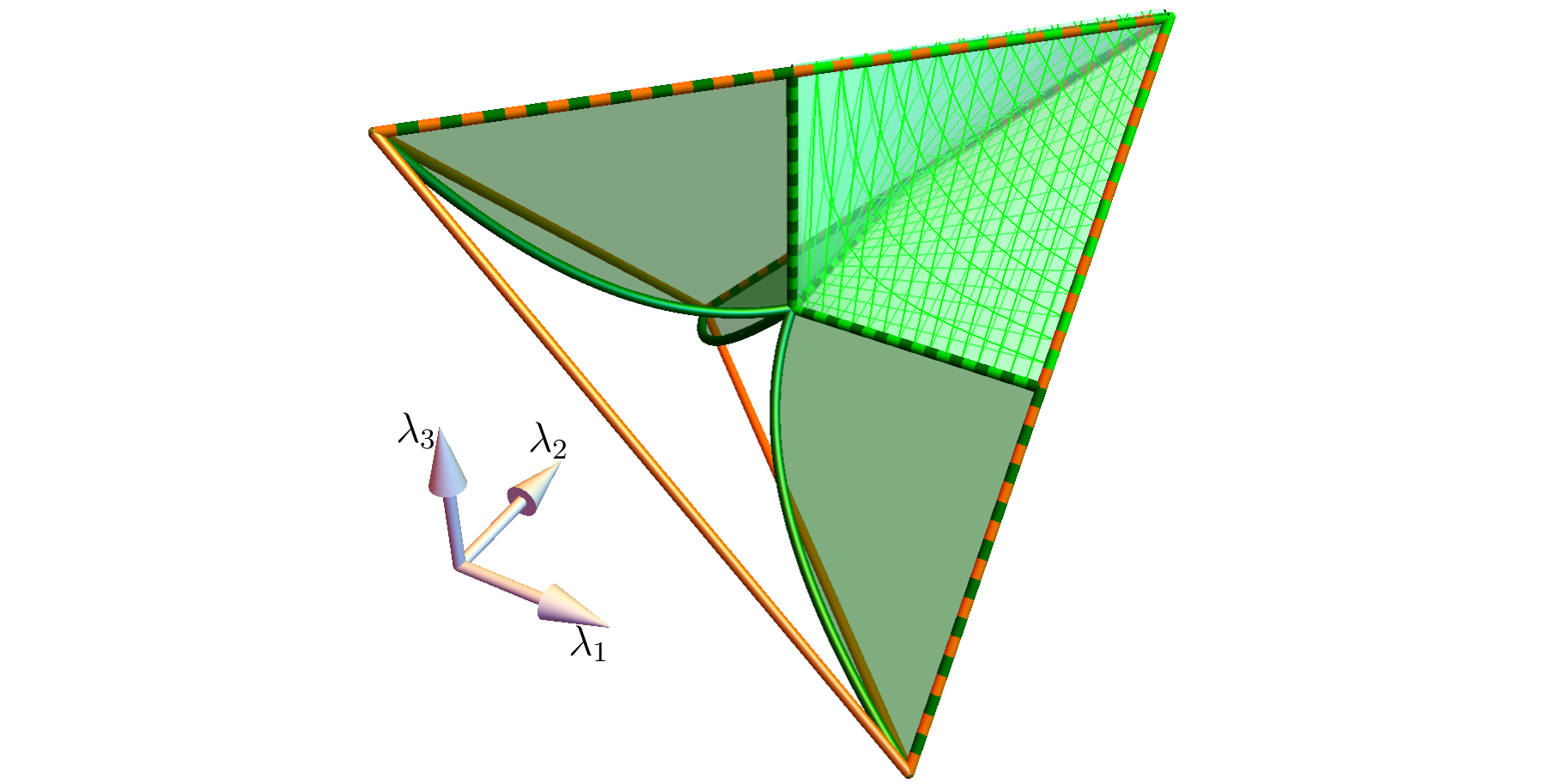 20.05.2019 Publication
20.05.2019 Publication
Divisibility of qubit channels and dynamical maps
The concept of divisibility of dynamical maps is used to introduce an analogous concept for quantum channels by analyzing the simulability of channels by means of dynamical maps. In particular, this is addressed for Lindblad divisible, completely positive divisible and positive divisible dynamical maps. The corresponding L-divisible, CP-divisible and P-divisible subsets of channels are characterized (exploiting the results by Wolf et al. and visualized for the case of qubit channels. We discuss the general inclusions among divisibility sets and show several equivalences for qubit channels. To this end we study the conditions of L-divisibility for finite dimensional channels, especially the cases with negative eigenvalues, extending and completing the known results. Furthermore we show that transitions between every two of the defined divisibility sets are allowed. We explore particular examples of dynamical maps to compare these concepts. Finally, we show that every divisible but not infinitesimal divisible qubit channel (in positive maps) is entanglement-breaking, and open the question if something similar occurs for higher dimensions.
by
David Davalos, Mario Ziman, and Carlos Pineda
Quantum 3, 144 (2019) | +++ | HiPhoP (Quantera), MAXAP (VEGA 2/0173/17), QETWORK (APVV-14-0878), GACR GA16-22211S |
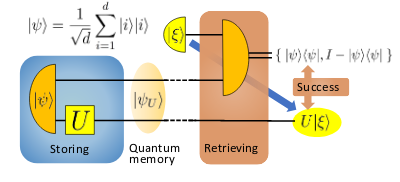 03.05.2019 Publication
03.05.2019 Publication
Optimal Probabilistic Storage and Retrieval of Unitary Channels
We address the question of quantum memory storage for quantum dynamics. In particular, we design an optimal protocol for N -> 1 probabilistic storage and retrieval of unitary channels on D-dimensional quantum systems. If we access the unknown unitary gate only N times, the optimal success probability of perfect single-use retrieval is N/(N−1+d2). The derived size of the memory system exponentially improves the known upper bound on the size of the program register needed for probabilistic programmable quantum processors. Our results are closely related to probabilistic perfect alignment of reference frames and probabilistic port-based teleportation.
by
Michal Sedlák, Alessandro Bisio, and Mário Ziman
Phys. Rev. Lett. 122, 170502 (2019) | +++ | HiPhoP (Quantera), MAXAP (VEGA 2/0173/17), QETWORK (APVV-14-0878), GACR GA16-22211S |
 16.04.2019 Publication
16.04.2019 Publication
Strong electron-electron interactions of a Tomonaga-Luttinger liquid observed in InAs quantum wires
We report strong electron-electron interactions in quantum wires etched from an InAs quantum well, a material generally expected to have strong spin-orbit interactions. We find that the current through the wires as a function of the bias voltage and temperature follows the universal scaling behavior of a Tomonaga-Luttinger liquid. Using a universal scaling formula, we extract the interaction parameter and find strong electron-electron interactions, increasing as the wires become more depleted. We establish theoretically that the spin-orbit interaction cause only minor modifications of the interaction parameter in this regime, indicating that genuinely strong electron-electron interactions are indeed achieved in the device. Our results suggest that etched InAs wires provide a platform with both strong electron-electron interactions and the strong spin-orbit interaction.
by
Yosuke Sato, Sadashige Matsuo, Chen-Hsuan Hsu, Peter Stano, Kento Ueda, Yuusuke Takeshige, Hiroshi Kamata, Joon Sue Lee, Borzoyeh Shojaei, Kaushini Wickramasinghe, Javad Shabani, Chris Palmstrøm, Yasuhiro Tokura, Daniel Loss, and Seigo Tarucha
Phys. Rev. B 99, 155304 (2019) | +++ | |
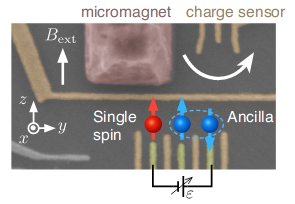 15.04.2019 Publication
15.04.2019 Publication
Quantum non-demolition measurement of an electron spin qubit
Measurements of quantum systems inevitably involve disturbance in various forms. Within the limits imposed by quantum mechanics, there exists an ideal projective measurement that does not introduce a back action on the measured observable, known as a quantum non-demolition (QND) measurement. Here we demonstrate an all-electrical QND measurement of a single electron spin in a gate-defined quantum dot. We entangle the single spin with a two-electron, singlet–triplet ancilla qubit via the exchange interaction and then read out the ancilla in a single shot. This procedure realizes a disturbance-free projective measurement of the single spin at a rate two orders of magnitude faster than its relaxation. The QND nature of the measurement protocol enables enhancement of the overall measurement fidelity by repeating the protocol. We demonstrate a monotonic increase of the fidelity over 100 repetitions against arbitrary input states. Our analysis based on statistical inference is tolerant to the presence of the relaxation and dephasing. We further exemplify the QND character of the measurement by observing spontaneous flips (quantum jumps) of a single electron spin. Combined with the high-fidelity control of spin qubits these results will allow for various measurement-based quantum state manipulations including quantum error correction protocols.
by
Takashi Nakajima, Akito Noiri, Jun Yoneda, Matthieu R. Delbecq, Peter Stano, Tomohiro Otsuka, Kenta Takeda, Shinichi Amaha, Giles Allison, Kento Kawasaki, Arne Ludwig, Andreas D. Wieck, Daniel Loss, and Seigo Tarucha
Nature Nanotechnology 14, 555–560 (2019) | +++ | |
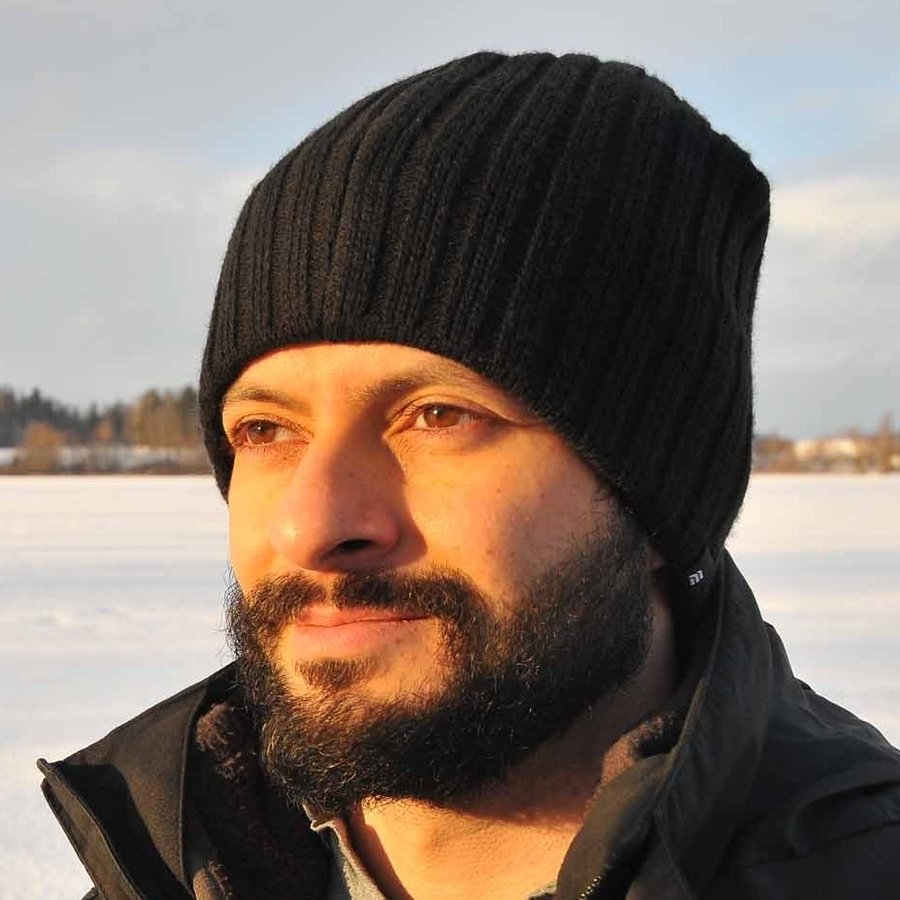 25.03.2019 People
25.03.2019 People
Dr. M. Hamed Mohammedy has joined our research group for 12 months as postdoctoral fellow. His current research interests cover quantum thermodynamics and quantum measurements. Welcome in our group. |
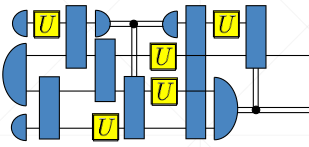 18.03.2019 Lectures
18.03.2019 Lectures
Quantum combs: General theory and applications Speaker: Michal Sedlák Series of hands-on lectures on modern mathematical formalism of higher-order quantum structures. 18.3.2019 (Monday) 10:00 - 12:00 20.3.2019 (Wednesday) 9:00 - 11:00 22.3.2019 (Friday) 10:00 - 12:00 25.3.2019 (Monday) 10:00 - 12:00 27.3.2019 (Wednesday) 10:00 - 12:00 29.3.2019 (Friday) 10:00 - 12:00 Place: seminar room of Research Center for Quantum Information, Bratislava |
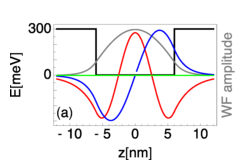 22.02.2019 Publication
22.02.2019 Publication
Orbital effects of a strong in-plane magnetic field on a gate-defined quantum dot
We theoretically investigate the orbital effects of an in-plane magnetic field on the spectrum of a quantum dot embedded in a two-dimensional electron gas (2DEG). We derive an effective two-dimensional Hamiltonian where these effects enter in proportion to the flux penetrating the 2DEG. We quantify the latter in detail for harmonic, triangular, and square potential of the heterostructure. We show how the orbital effects allow one to extract a wealth of information, for example, on the heterostructure interface, the quantum dot size and orientation, and the spin-orbit fields. We illustrate the formalism by extracting this information from recent measured data [L. C. Camenzind et al., arXiv:1804.00162; Nat. Commun. 9, 3454 (2018)].
by
Peter Stano, Chen-Hsuan Hsu, Leon C. Camenzind, Liuqi Yu, Dominik Zumbühl, and Daniel Loss
Phys. Rev. B 99, 085308 (2019) | +++ | |
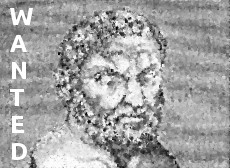 11.02.2019 Job opening
11.02.2019 Job opening
Postdoc position We are opening a one-year postdoc position in the area of theoretical quantum information theory. The postdoc is expected to work in close collaboration with core members of RCQI on topics of their common interests (quantum communication, quantum complexity theory, quantum simulations, quantum foundations, etc.). Basic salary is 1400 eur / month, however, additional funds, depending on the focus and performance, are expected. The position is offered for one year, but there is a possibility for one-year extension. The position is funded by Institute of Physics of Slovak Academy of Sciences. The application consists of CV (including list of publications), research statement (short summary of personal research interests and plans), and three names of potential referees we might ask for recommendation. Please send all this information to Mario Ziman by email (ziman@savba.sk) before February 28th. We are aiming to start as early as possible. Selected candidates will be interviewed (online) and/or invited to give a seminar at our research center. The research performance and experience of the candidate will be the only selection criteria. |
 01.02.2019 Job opening
01.02.2019 Job opening
PhD positions available Interested to join our research team for four years of you life? That is exactly the time the PhD study takes. Currently, we have open several PhD positions in our Institute. We are open for submissions until the positions are filled (latest 31/05/2019) with PhD starting in September 2019. If interested, as the first step, please get in contact with a potential PhD advisor (send them your cv and motivation letter), discuss the subject and follow his/her instructions. Do not wait until submission deadline and do this as soon as possible, because the number of positions is limited. |
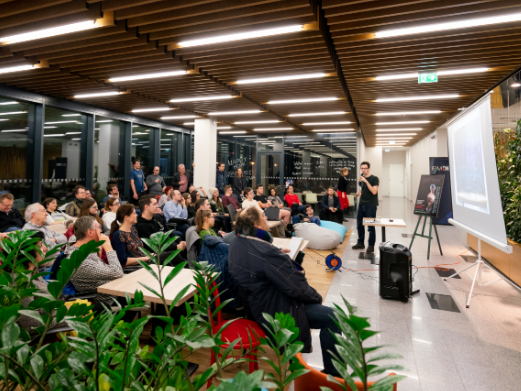 30.01.2019 Popular
30.01.2019 Popular
Čo nedokážu ani počítače budúcnosti? / What we won't be able to do on the computers we don't have yet? Our colleague Daniel Nagaj is giving a SAVinci popular-science talk [in Slovak] on quantum computers. It is part of a series of science-coffee events organized by Slovak Academy of Sciences. ... read more ... Place: Westend Gate Lobby, Dúbravská cesta, Bratislava - Patrónka Time: Wednesday 30/01/2019, 17:30 |
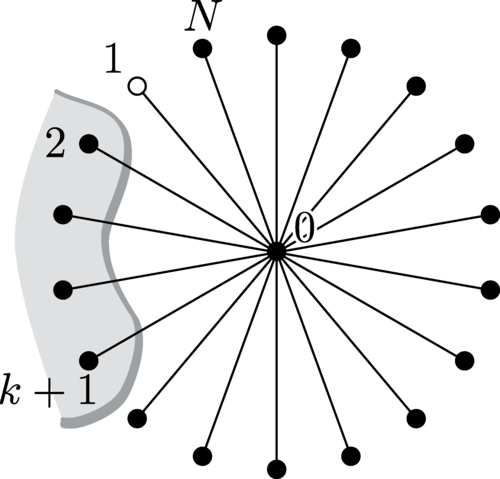 23.01.2019 Publication
23.01.2019 Publication
Grover search under localized dephasing
Decoherence in quantum searches, and in the Grover search, in particular, has already been extensively studied, leading very quickly to the loss of the quadratic speedup over the classical case, when searching for some target (marked) element within a set of size N. The noise models used were, however, almost always global. In this paper, we study Grover search under the influence of localized partially dephasing noise of rate p. We find that, in the case when the size k of the affected subspace is much smaller than N and the target is unaffected by the noise, namely when kp≪√N, the quadratic speedup is retained. Once these restrictions are not met, the quadratic speedup is lost. If the target is affected by the noise, the noise rate needs to scale as 1/√N to keep the speedup. We also observe an intermediate region, where if k∼Nμ and the target is unaffected, the speedup seems to obey Nμ, which for μ>0.5 is worse than the quantum, but better than the classical case. We also put obtained results for quantum searches into perspective of quantum walks and searches on graphs.
by
Daniel Reitzner and Mark Hillery
Phys. Rev. A 99, 012339 (2019) | +++ | SASPRO 0055/01/01, MAXAP (VEGA 2/0173/17), QETWORK (APVV-14-0878) GACR GA16-22211S |
 22.01.2019 Publication
22.01.2019 Publication
Quantum information processing and composite quantum fields
Some beautiful identities involving hook contents of Young diagrams have been found in the field of quantum information processing, along with a combinatorial proof. We here give a representation theoretic proof of these identities and a number of generalizations. Our proof is based on trace identities for elements belonging to a class of permutation centralizer algebras. These algebras have been found to underlie the combinatorics of composite gauge invariant operators in quantum field theory, with applications in the AdS/CFT correspondence. Based on these algebras, we discuss some analogies between quantum information processing tasks and the combinatorics of composite quantum fields and argue that this can be fruitful interface between quantum information and quantum field theory, with implications for AdS/CFT.
by
Sanjaye Ramgoolam and Michal Sedlák
J. High Energ. Phys. 2019, 170 (2019) | +++ | HIPHOP (QuantERA project 731473), QETWORK (APVV-14-0878), MAXAP (VEGA 2/0173/17) |


